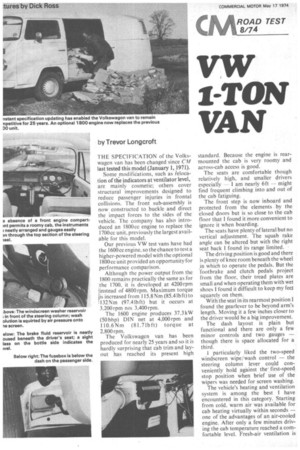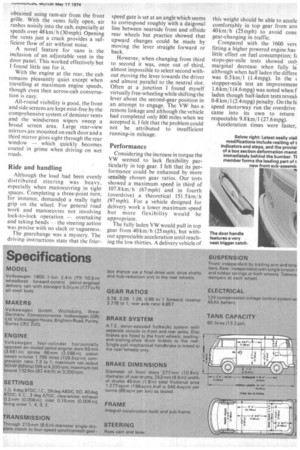VW i-TON VAN
Page 40

Page 41

Page 42

If you've noticed an error in this article please click here to report it so we can fix it.
by Trevor Longcroft THE SPECIFICATION of the Volkswagen van has been changed since CM last tested this model (January 1, 1971).
Some modifiCations, such as felocation of the indicators at ventilator level, are mainly cosmetic; others cover structural improvements designed to reduce passenger injuries in frontal collisions. The front sub-assembly is now constructed to buckle and direct the impact forces to the sides of the vehicle. The company has also introduced an 1800 cc engine to replace the 1700 cc unit, previously the largest available for this model.
Our previous VW test vans have had the 1600cc engine, so the chance to test a higher-powered model with the optional 1800 cc unit provided an opportunity for performance comparison.
Although the power output from the 1800 remains practically the same as for the 1700, it is developed at 4200 rpm 'instead of 4800 rpm. Maximum torque is increased from 115.8 Nm (85.41b ft) to 132Nm (97.41bft) but it occurs at 3.200 rpm noi 3,400rpm.
The 1600 engine produces 37.3 kW (50 bhp) DIN net at 4,000 rpm and
110.6 Nm (81.71b ft) torque at 2,800 rpm.
The Volkswagen van has been produced for nearly 25 years and so it is hardly surprising that cab trim and layout has reached its present high standard. Because the engine is rearmounted the cab is very roomy and across-cab access is good.
The seats are comfortable though relatively high, and smaller drivers
especially I am nearly 6ft — might find frequent climbing into and out of the cab fatiguing.
The front step is now inboard and protected from the elements by the closed doors but is so close to the cab floor that I found it more convenient to ignore it when boarding.
The seats have plenty of lateral but no vertical adjustment. The squab rake angle can be altered but with the right seat back I found its range limited. •
The driving position is good and there is plenty of knee room beneath the wheel in which to operate the pedals. But the footbrake and clutch pedals project from the floor, their tread plates are small and when operating them with wet shoes I found it difficult to keep my fees squarely on them.
With the seat in its rearmost position I found the gearlever to be beyond arm's length. Moving it a few inches closer to the driver would be a big improvement.
The dash layout is plain but functional and there are only a few minor controls and two gauges — though there is space allocated for a third.
1 particularly liked the two-speed windscreen wipe/wash control — the steering column lever could conveniently hold against the' first-speed stop position when brief use of the wipers was needed for screen washing.
The vehicle's heating and ventilation system is among the best I have encountered in this category. Starting from cold, warm air was available for cab heating virtually within seconds — one of the advantages of an air-cooled engine. After only a few minutes driving the cab temperature reached a comfortable level. Fresh-air ventilation is obtained using ram-air from the front grille. With the vents fully open, air rushes noisily into the cab, especially at speeds over 48km/ h (30 mph). Opening the vents just a crack provides a sufficient flow of air without noise.
A novel feature for vans is the inclusion of an adjustable vent in the door panel. This worked effectively but I found little use for it.
With the engine at the rear, the cab remains pleasantly quiet except when travelling at maximum engine speeds, though even then across-cab conversation is easy.
All-round visibility is good, the front and side screens are kept mist-free by the comprehensive system of demister vents and the windscreen wipers sweep a broad screen area. Large rear-view mirrors are mounted on each door and a third mirror gives sight through the rear window -which quickly becomes coated in grime when driving on wet roads.
Ride and handling
Although the load had been evenly distributed steering was heavy, especially when manoeuvring in tight spaces. Completing a three-point turn. Tor instance, demanded a really tight grip on the wheel. For general road work and manoeuvres not involving lock-to-lock operation — overtaking and taking bends -the steering action was precise with no slack or vagueness.
The gearchange was a mystery. The driving instructions state that the fciur speed gate is set at an angle which seems to correspond roughly with a daigonal line between nearside front and offside rear wheels but practice showed that upward changes could be made by moving the lever straight forward or back.
However, when changing from third to second it was, once out of third, almost impossible to select second without moving the lever towards the driver and almost parallel to the neutral slot. Often at a junction I found myself virtually free-wheeling while shifting the lever about the second-gear position in an attempt to engage. The VW has a remote linkage and although the vehicle had completed only 800 miles when we accepted it, I felt that the problem could not be attributed to insufficient running-in mileage.
Performance
Considering the increase in torque the VW seemed to lack flexibility particularly in top gear. I felt that its performance could be enhanced by more sensibly chosen gear ratios. Our tests showed a maximum speed in third of 107.8km/ h (67mph) and in fourth (overdrive) a theoretical 151.5 km/ h (97 mph). For a vehicle designed for delivery work a lower maximum speed but more flexibility would be appropriate.
The fully laden VW would pull in top gear from 40 km/h (25 mph), but without appreciable acceleration until reaching the low thirties. A delivery vehicle of this weight should be able to accele comfortably in top gear from aro 40 km/h (25 mph) to avoid cons gear-changing in traffic.
Compared with the 1600 vers fitting a higher powered engine has little effect on fuel consumption: fc stops-per-mile tests showed mil! marginal decrease when fully la although when half laden the cliffere was 0.5 km/1 (1.4mpg). In the ( stopper-mile test an improvement 1.6km/1(4.6mpg) was noted when f laden though half-laden tests reveal' 0-8 km/1(2.4mpg) penalty. On the hi speed motorway run the overdrive came into its own to return respectable 9.8 km/1 (27.6 mpg).
Acceleration times were faster, The larger engine has also boosted hill-climbing performance, clipping 37.5 seconds off the time achieved to climb Bison Hill with the less powerful 1600: and 14 seconds were clipped off the time for lowest gear use (see table).
Restarting in reverse on a 1 in 6.5 gradient could be accomplished only by slipping the clutch excessively.
Because of the rear engine "cabinet", the VW van does not have conventional rear loading doors. Nevertheless, the sliding door is as wide as most rear ones and loading does not present difficulties. The side door is especially convenient for kerbside loading/unloading. Long items such as ladders or planks can be usefully fed in through the small rear door. When carrying cargo on the engine compartment, a restraint system should be used to prevent the load shooting into the main area upon braking.
A useful feature is a gap between the driver and passenger seats which permits easy entry into the load space.
Summing up
Summing up, fitting the 1800 cc engine provides a more spritely alternative to the 1600 with only a marginal difference in consumption. However, it seems that some of the potential advantages of increased output have been lost through poor ratio specification.
An air-cooled engine has obvious maintenance advantages over the watercooled versions. but the engine is tucked away, making access more difficult than in normal-control models.
As tested, the Volkswagen costs. £1,510.50 excluding VAT.








































































































